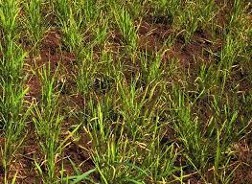
Aluminum (Al) Toxicity

Aluminum (Al) toxicity in soil inhibits the growth of plant shoots by causing nutrient deficiencies in Magnesium (Mg), Calcium (Ca), and Phosphorus (P).
It can also lead to draught stress and plant hormone imbalance.
Al toxicity is relatively rare in irrigated rice systems. It rarely occurs in lowland rice except in some soils where there is very slow soil reduction after flooding.
Al toxicity is one of the major factors in limiting crop production on acid upland soils, and can be a major source of yield loss.
Al toxicity occurs on the following soils:
- acid upland soils with large exchangable Al content. Al toxicity often occurs together with Manganese (Mn) toxicity.
- flooded soil with pH < 4 ( before Iron (Fe) toxicity appears)
How to identify (symptoms)
- Orange-yellow interveinal chlorosis can be found on leaves.
- When severe , leaf margin scorch, dicolored areas and leaf tips die.
- poor stunted growth and deformed roots in susceptible varieties

How to manage
- Plant tolerant varieties by contacting your local agricultural office for an up to date list of available varieties.
- Manage fertilizers efficiently
- Delay planting until pH has increased sufficiently after flooding ( to immobilize Al)
- recycle straw or ash in the field to replenish Silicon (Si) removed.